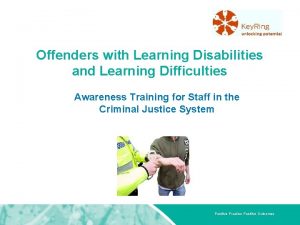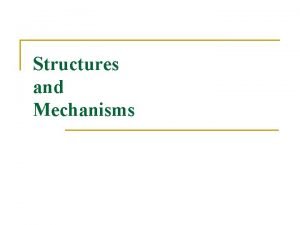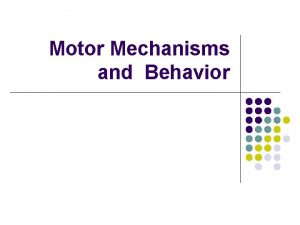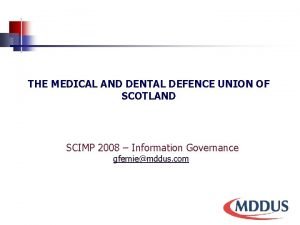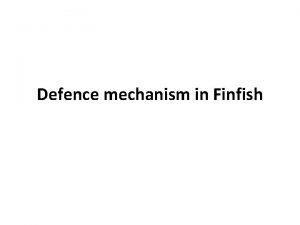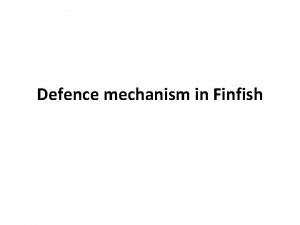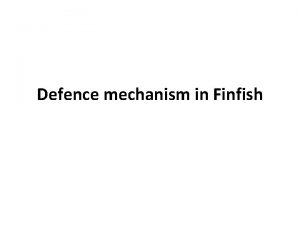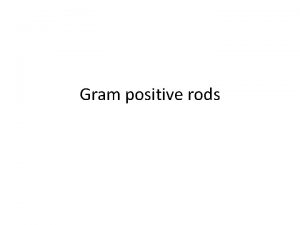Lesson 2 DEFENCE MECHANISMS AND POSITIVE STRATEGIES Defence
















- Slides: 16

Lesson 2 DEFENCE MECHANISMS AND POSITIVE STRATEGIES

Defence Mechanisms Techniques you used to protect yourself from being hurt emotionally. Can be helpful but using repeatedly is not good for one’s health as it avoids facing the issue.

Common Defence Mechanisms Mechanism Description Examples Compensation Covering a weakness Focusing all your attention by over achieving in on sports because you think another area you are a better athlete than student Daydreaming Escaping from an unpleasant situation by using your imagination In the dentist’s chair you focus on the fun you’ll have over the weekend because you hate being at the dentist

Common Defence Mechanisms Mechanism Denial Description Failure to except reality Displacement The transfer of Examples Refusing to accept the death of a close friend or relative; refusing to accept that you relationship with a romantic friend is over. You are very angry with negative feelings your mother and you take about someone else that anger out on your siblings

Common Defence Mechanisms Mechanism Projection Description Examples Putting Blaming your teacher (projecting) for failing a test you did negative feelings not study for. on someone else Rationalization Justifying irrational behaviour Not doing your homework one evening because you feel you’ve spent too much time on schoolwork

Common Defence Mechanisms Mechanism Description Examples Reaction formation Expressing emotions that are the exact opposite of what you feel Acting like a clown in a group to hide your shyness Regression Using childlike ways of expressing emotions like anger or disappointment Throwing a tantrum when you don’t get to watch your favourite TV program

Common Defence Mechanisms Mechanism Sublimation Somatization Description Examples Redirecting bad or unacceptable behaviour into positive behaviour Converting emotions into bodily symptoms Channelling your aggression into a athletic sport where aggressive behaviour is accepted. Getting stomach cramps every time final exams are scheduled.

Self Esteem Feeling good about yourself and the things you do Gives sense of confidence Make a list of things you do well Pay attention to positive aspects in your life

Self Esteem Use positive self talk Talk to yourself in a positive way – I’m really good at this Avoid all negative self talk

Self Esteem Be good at something Developing your skill in whatever you are good at will make you more confident

Self Esteem Resist peer pressure The more you make decisions based on what you think and not others the more confident you will become.

Self Esteem Accept yourself Appreciate yourself and believe in your worth Realistically assess your strengths and weaknesses Do not judge yourself by unrealistic standards Be ok with who you are right now Only expend energy on changing things you have control over.

Self Esteem Use I statements Take responsibility for your feelings and words by using “I” statements

Sense of Control High self esteem gives you a sense of control internal locus of control Those with low self esteem feel that events affecting them are beyond their control. External locus of control The reality is that you will always have some control in your life

Self Concept The current mental image you have of yourself Rating your level of self esteem requires you to evaluate how you look at yourself as a person. Self-ideal – The mental image of what you would like to be. If you self-ideal is realistic, set goals to reach it.

Questions – hand in 1. 2. 3. 4. 5. Why do people use defence Mechanisms? I (1) How are Esteem Needs related to Self-ideal? I (1) Why is self esteem important to you? I (1) How can someone increase their self esteem? I (1) Do you think that the ideas behind Maslow’s Hierarchy of needs should be used more in this school? -Example: breakfast programs, self help group. I(2)
 Gram positive catalase positive
Gram positive catalase positive What's 8 + 5
What's 8 + 5 Positive practice positive outcomes
Positive practice positive outcomes Virtualization structures/tools and mechanisms ppt
Virtualization structures/tools and mechanisms ppt Structure and mechanism
Structure and mechanism Magnetic read and write mechanisms
Magnetic read and write mechanisms Basic mechanisms underlying seizures and epilepsy
Basic mechanisms underlying seizures and epilepsy Sensory and motor mechanisms
Sensory and motor mechanisms Security services and mechanisms in cryptography
Security services and mechanisms in cryptography Internal service delivery mechanisms
Internal service delivery mechanisms Security attacks services and mechanisms
Security attacks services and mechanisms Managing weight and eating behaviors
Managing weight and eating behaviors National mechanisms for reporting and follow-up
National mechanisms for reporting and follow-up Medical and dental defence union of scotland
Medical and dental defence union of scotland Nanosystems in security and defence
Nanosystems in security and defence Defence centre for languages and culture
Defence centre for languages and culture Aerospace and defense industries association of europe
Aerospace and defense industries association of europe


